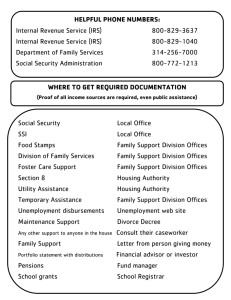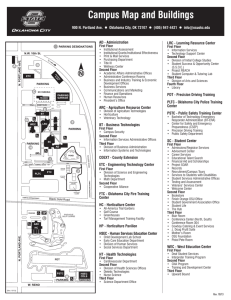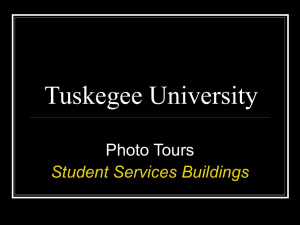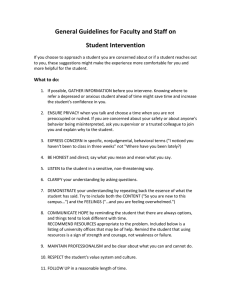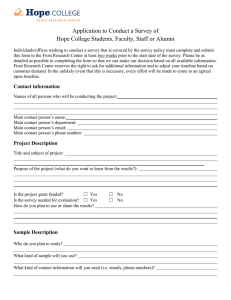Faculty Offices Feasibility Study
advertisement
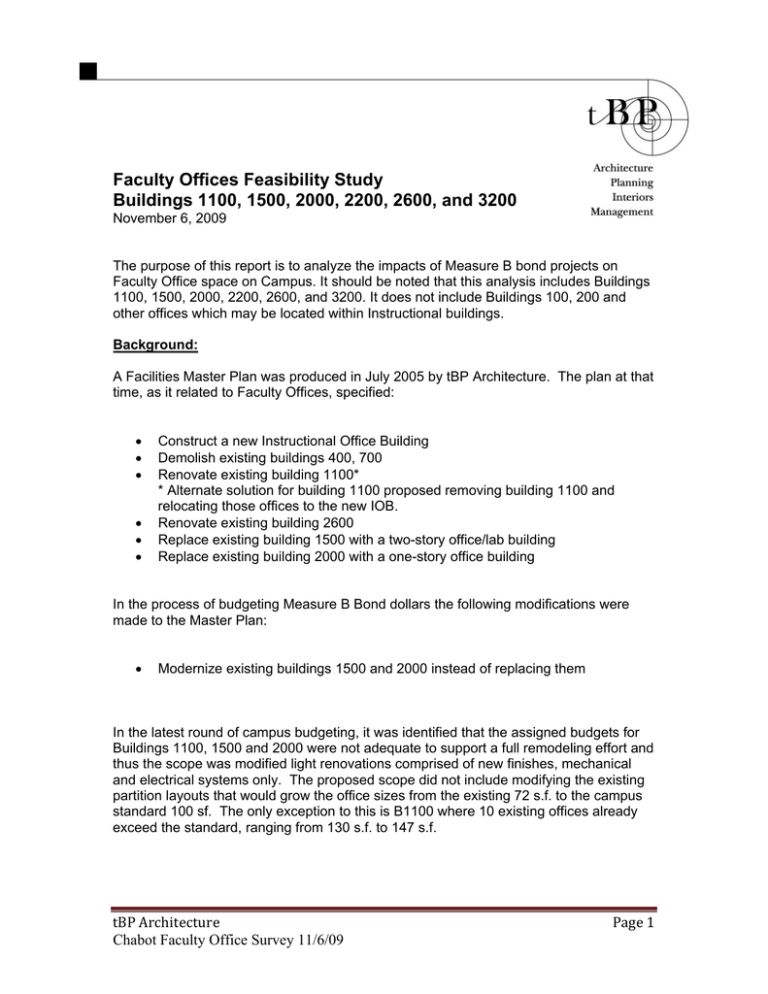
Faculty Offices Feasibility Study Buildings 1100, 1500, 2000, 2200, 2600, and 3200 November 6, 2009 The purpose of this report is to analyze the impacts of Measure B bond projects on Faculty Office space on Campus. It should be noted that this analysis includes Buildings 1100, 1500, 2000, 2200, 2600, and 3200. It does not include Buildings 100, 200 and other offices which may be located within Instructional buildings. Background: A Facilities Master Plan was produced in July 2005 by tBP Architecture. The plan at that time, as it related to Faculty Offices, specified: Construct a new Instructional Office Building Demolish existing buildings 400, 700 Renovate existing building 1100* * Alternate solution for building 1100 proposed removing building 1100 and relocating those offices to the new IOB. Renovate existing building 2600 Replace existing building 1500 with a two-story office/lab building Replace existing building 2000 with a one-story office building In the process of budgeting Measure B Bond dollars the following modifications were made to the Master Plan: Modernize existing buildings 1500 and 2000 instead of replacing them In the latest round of campus budgeting, it was identified that the assigned budgets for Buildings 1100, 1500 and 2000 were not adequate to support a full remodeling effort and thus the scope was modified light renovations comprised of new finishes, mechanical and electrical systems only. The proposed scope did not include modifying the existing partition layouts that would grow the office sizes from the existing 72 s.f. to the campus standard 100 sf. The only exception to this is B1100 where 10 existing offices already exceed the standard, ranging from 130 s.f. to 147 s.f. tBP Architecture Chabot Faculty Office Survey 11/6/09 Page 1 Campus Faculty: Chabot College Full Time Faculty List Dated 6/3/2009 (Exhibit A) lists a total of 194 faculty including vacancies. We believe the number of faculty assigned to the subject buildings is 165 Faculty. Chabot Faculty Adjunct Faculty Mailbox List Fall 2009 (Exhibit B) lists a total of 302 adjunct faculty. We believe all of these people are assigned to the subject buildings. Pre-Existing Conditions: Before the Bond projects, there were 224 faculty offices in the subject buildings with an average size of 75 ASF. The overall assignable area for these offices was 16,913 ASF excluding deans offices, meeting rooms, workrooms, and other support spaces. The overall office space in these buildings was 20,092 ASF. On the surface level, it may appear that the 224 offices were adequate for the 165 faculty. However, after discussion with the Deans, it is clear that the 302 Adjuncts were sharing remaining 59 faculty offices. This would average 5 adjuncts per office. There were and are a number of issues with the pre-existing office spaces. The 75 sf average office size is not adequate to accommodate a private conversation between an instructor and a student. There is very limited meeting space in the buildings exacerbating the privacy issues. The Deans’ offices are undersized, not capable of accommodating more than 1 or two guests. This put further pressure on the limited meeting spaces. Adjuncts were sharing spaces not designed to be shared. Our assumption is that this led to a game of musical chairs with some senior adjuncts getting private offices and others packing into limited remaining space. tBP Architecture Chabot Faculty Office Survey 11/6/09 Page 2 Planned Secondary Effects by Division Deans: We have met with the affected Deans* and they have put forward the following plans for vacated space: *Data from the Deans follows in appendix. Building 1100 21 existing faculty office 4 office users moving to IOB Those 4 empty offices being filled by: 2 faculty currently without offices 2 reserved for future hires In addition, 1 office being used by adjunct faculty, 1 office being shared by 10 adjuncts and 1 office used by staff. Building 1500 19 existing faculty offices 10 office users moving to IOB Those 10 empty offices being filled by: o 4 adjunct offices to be shared o 4 offices to be devoted to Chabot WEB Services o 1 office for Fire Storage o 1 office for future hire Building 2000 52 existing faculty offices 7 office users moving to IOB o Those 7 offices being filled by: Most likely, additional adjunct offices In addition, 1 office being used by credit union, 3 offices being used by science, nursing and EMT adjuncts. Building 2200 10 existing faculty offices 1 office user moving to IOB o That 1 office being filled by:TBD In addition, 1 office vacant for future hire, 1 office for adjuncts Building 2600 16 existing faculty offices 4 office users moving to IOB plus 1 new hire o Those 4 offices will be lost to attrition in the renovation In addition new design will accommodate 10 offices, 1 Asst. Dean and 1 shared adjunct office with 3 stations tBP Architecture Chabot Faculty Office Survey 11/6/09 Page 3 Impact of Measure B of Faculty Office Space: Buildings 400 and 700 have been demolished with their 102 faculty offices, 3 Deans Suites, meeting and work space. All of these spaces were well below Campus Standard sizes. The new Instructional Office Building, when completed, will add 122 faculty offices, 15 adjunct workstations, 4 Dean’s suites, along with meeting and workrooms space. All of these spaces are per Campus standards and larger than their predecessors. Building 1100, 1500, and 2000 are now scheduled for cosmetic/clean-up renovations only. The result will be to maintain the same number and sizes of offices in these buildings. This will perpetuate the problems in these buildings. Building 2600 is planned as a major renovation. The overall number of faculty offices will be reduced in order to allow the faculty office size to be increased to the Campus standard. An adjunct pod is also planned. Buildings 2200 and 3100 are not planned for renovation at this time. They are included in this analysis to capture the faculty offices in the overall count. It should be noted that the offices in these buildings are below the Campus standard size. Many former faculty offices were being used as adjunct offices. The IOB routes a great number of these adjuncts into higher efficiency space. The result is a net gain in vacant existing faculty offices. Overall, the Bond program nets o 14 Additional Faculty offices. o 15 Adjunct workstations, serving up to 75 instructors. o One Additional Deans Suite. o Additional Meeting Rooms and workspace o 9381 ASF additional office space, 4976 ASF of which is individual Faculty offices . tBP Architecture Chabot Faculty Office Survey 11/6/09 Page 4 Campus Standards with relation to 1100, 1500 and 2000. 1100, 1500 and 2000 contain an excess of offices than is required. However, these spaces are undersized and not wheelchair accessible. This is exacerbated by a lack of meeting spacing in these buildings. The surplus of offices is used by the adjunct faculty at a rate of approximately 5 per office. If these buildings were reconfigured per the Campus standards it has the following impact. Available Office ASF in Building 1100 Available Office ASF in Building 1500 Available Office ASF in Building 2000 Total Available Office ASF 1100, 1500, 2000 43 Standard Faculty offices (1) 21 50 Adjunct Workstations (2) 50 5 Small Conference Rooms (3) 5 3 Medium Conference Rooms (4) 3 3 Large Conference Rooms (5) 3 3 Division Work Rooms 3 3 Deans suites 3 Total Area required to provide Campus standard office space Additional area required to provide Campus standard space 2752 2007 4141 8900 100 70 100 300 900 180 400 2100 3500 500 900 2700 540 1200 11440 2540 The existing space in 1100, 1500 and 2000 is 2540 ASF less than required to provide Campus standard space to remaining faculty. Footnotes: (1)The completion of the IOB and renovation of 2600 will yield 132 new Faculty offices. Records indicate that there are currently 165 full time positions on Campus. It is assumed that staff in 2200 and 3100 will remain in existing non-standard offices (14). We included a 10% growth factor.(165132-14) x 110% =21 offices (2)The completion of the IOB and renovation of 2600 create 15 Adjunct workstations. The Campus standards state that 5 adjuncts can share one workstation. Thus these 15 workstations accommodate 75 Adjunct Faculty. There are currently 302 adjuncts and thus the remaining 227 will need space. We included a 10% growth factor 227 x 110%/5= 50 workstations. (3)Campus Standards call for Small meeting rooms to be interspersed among Campus offices. We calculate 5 additional Small meeting rooms will be required 5 x 100=500 ASF (4) Campus Standards also call for one medium sized conference room per division. As PE is provided for in 2600, 3 additional rooms would be required.3 x 300= 900 ASF. (5) Lastly, Campus standards call for one large conference room per building or floor. As there are three buildings in question, there would be: 3 x 900 = 2700 ASF tBP Architecture Chabot Faculty Office Survey 11/6/09 Page 5 Conclusion: With the completion of the IOB, the amount of office space on campus will be slightly more than the Cap Load. There will be approximately the correct amount of office space on campus although it’s configuration is inefficient and does not meet ADA requirements. When considering the renovation of Chabot buildings 1100, 1500, and 2000, there are several options 1. Cosmetic upgrades to existing buildings. a. This is the least cost solution and is currently budgeted. i. There will be a disparity between the new and pre-existing office size. ii. All of the offices, including the Deans would remain inaccessible to the Disabled. iii. Adjunct Space, although roughly per standards, will continue to be provided in surplus faculty offices. This type of arrangement will lead to lack of availability at peak times. iv. The divisions which remain in the old buildings will still be challenged to find meeting space to compensate for their undersized offices. 2. Reconfiguration of buildings to address Campus Standards: a. Area Calculations technically show that 1100, 1500 and 2000 could be reconfigured to address the Campus needs provided there is flexibility in Campus meeting room size and quantity. i. However, these buildings are approaching 50 years old. Buildings would require structural upgrades, abatement, fire sprinklers and other upgrades. ii. Adjusting the footprint would undoubtedly be inefficient due to existing structural constraints. The buildings will have less 25-40% offices than exist today. iii. This would lead to the splitting of some divisions into separate buildings. 3. New Building(s) a. Given the constraints of Option 2, replacement of one or more of these buildings may be a viable option. b. The new building could likely be built without a need for further swing space. tBP Architecture Chabot Faculty Office Survey 11/6/09 Page 6
